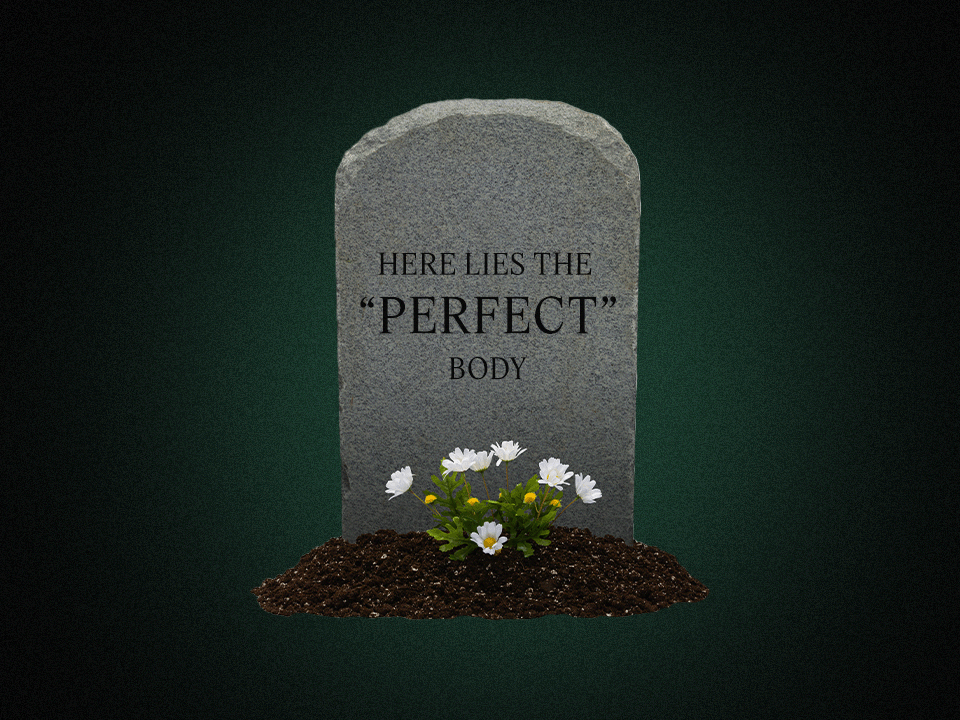Why Body Grief Is the New Body Neutrality
Pour one out for those societal expectations we’ll never meet.
At this point, most of us are probably familiar with the body positivity movement and the call to feel good about our physical forms and all they can do, regardless of what they look like—or even because of it. You might also be well-versed in that movement’s more realistic sequels: body neutrality and body acceptance. And while all of these mindsets can improve your relationship with food, exercise, clothes, and doctor’s appointments, getting there can feel impossible.
That’s partially because we live in a world where bodies, particularly feminine-presenting bodies, are heavily scrutinized. And since it’s so easy to fall into the trap of scrolling through content promoting society’s fat-phobic, ableist standard of what a body should look like, no one would blame you for feeling sad, shameful, frustrated, or angry about not meeting that criterion.
But if you’re forcing yourself to just love your body already, you’re basically trying to bypass those very real, very intense emotions that need to be investigated and processed before you can move past them. It’s kind of like shouting, “My body is amazing!” into a void in hopes that one day you’ll start to believe it.
The thing is, emotions don’t go away because you want them to. In order to heal your body image wounds, you have to feel them. That’s why the grieving process, which enables you to really sit with and think about the origin of those intense feelings, is an important part of coming to terms with the body you have.
Still, it’s not easy. As a licensed social worker, even with all the tools and coping strategies that I’ve learned, I too have struggled with accepting my own body and have spent time picking myself apart because I didn't look like what I considered desirable.
Clients have talked to me about the same issue, as well as how hard it is to see their shape change after having kids, as they grow older, or even as a result of taking medication to manage an illness. And because our bodies are the vessels in which we move through life, that emotional pain can feel inescapable.
So instead of willpower-ing our way to body neutrality—or even positivity—we have to own these tough emotions. We need to grieve the body we wish we had in order to accept the one we’ve got. This process can be a powerful tool that enables you to address the pain of not having the body you want. Then you can begin to let go of the idea that you need to look a certain way in order to be happy. As you move through that, you’ll get closer to accepting your body as it is. Here’s how to do just that.
How to grieve the body you wish you had.
1. Acknowledge your feelings.
Allow yourself to feel sad, angry, frustrated, or any other emotion that comes up when you think about the body you want. That could look like taking a pause the next time you catch a glimpse of yourself in the mirror or try on clothes that used to fit. Sit with whatever comes up, instead of pressuring yourself to feel positive when you just don’t. You could tell yourself, Yep, I’m feeling really angry that this is what I’ve got and sad that it’s not going to change. Remember that all emotions, even the heavy ones, deserve your attention.
2. Spend time identifying exactly what you’re grieving.
Are you feeling the loss of the body you had before an injury, illness, or kids? Or maybe it’s the fact that you’ll never look the way you wish you did (even if that’s an unrealistic ideal created by the patriarchy). Carve out some time in your schedule to think or journal about what you feel you lost or missed out on. If you can, see if you can dig into why that loss affects you so deeply. Is it unrealistic external expectations, fat-phobia or discrimination you’ve faced IRL, accessibility to things others take for granted, or another injustice sparked by the way you look? Even if you feel bad about feeling bad, being honest about the source of your grief is an important step.
3. Write a eulogy.
This may sound strange or dark, but writing a speech or essay memorializing your ideal body can be a powerful way to acknowledge your feelings and begin to move on. If you’re eulogizing the way your body used to be, write down the things you loved about it. If you’re trying to get past the body you never had, focus on why that ideal meant so much to you and why it’s so hard for you to live without it.
4. Create a ritual.
Grieving can make you feel sad and sort of hopeless, so it’s helpful to add in some exercises to avoid getting sucked into a pit of despair. Enter, rituals. These enable us to develop healthy habits to manage negative thoughts and stay mindful. It could be something as simple as writing yourself a little compliment on a sticky note that you can read to yourself as you brush your teeth to set a more positive tone for the day.
If that feels like too big of a departure from your grieving process, your ritual could look like pausing to do a quick breathing exercise every time negative thoughts about your body overwhelm you. Box breathing is a great option: Inhale for a count of four, pause for another count of four, exhale for the same amount of time, then hold for four more counts before starting over. You can do that as long as you need until you feel more present.
5. Filter your feeds.
If you spend a lot of time on social media (no judgment), your grieving process could be stunted by people or accounts that trigger negative self-talk about your body. Doing a little feed reset so that you only follow people who make you feel good will give you more space to mourn and come to terms with your body.
6. Take as long as you need.
Grief is fluid. It’s this heavy thing that takes many shapes over the course of time. One second you might be feeling your best and the next a trigger might cause you to grieve again. When that happens, just give yourself a gentle reminder that this isn’t always a linear process. That said, if you ever find that there are only lows for weeks or months at a time, consider seeking out a mental health professional who can guide you on this journey and give you the tools you need to manage your grief.
How to move from body grief to body neutrality.
So, yes, grieving is essential for accepting the reality of your current body. It allows you to process all of the hard emotions around that loss. And if you give yourself the time and space to experience it, you’ll be more likely to let go of the idea that you need to look a certain way to be happy or healthy.
That said, there are steps you can take to make that transition from grief to acceptance a little quicker.
1. Focus on what your body can do.
Maybe you can run a mile or taste coffee or enjoy the feeling of the sun on your skin. Celebrate those things. You can also try new activities that help you appreciate its capabilities.
2. Surround yourself with body-neutral people.
Consider joining body-positive groups or communities, attending events that promote body diversity, or simply being more mindful of the messages you consume through media and social media. When you’re around others who celebrate all body types, not just those that fit a narrow definition of beauty, you can begin to see the worthiness of all bodies.
3. Practice self-compassion.
Treat yourself the way you would a good friend. Speak to yourself kindly as much as you can, but don't beat yourself up when negative thoughts come up. Cultivating a sense of gratitude can also promote self-compassion. So take time to appreciate the little things, such as how your body feels after a warm shower or a good meal or how it adapts and heals itself when sick or injured. Remember, your body is unique and worthy of love and acceptance just the way it is.
Wondermind does not provide medical advice, diagnosis, or treatment. Any information published on this website or by this brand is not intended as a replacement for medical advice. Always consult a qualified health or mental health professional with any questions or concerns about your mental health.




